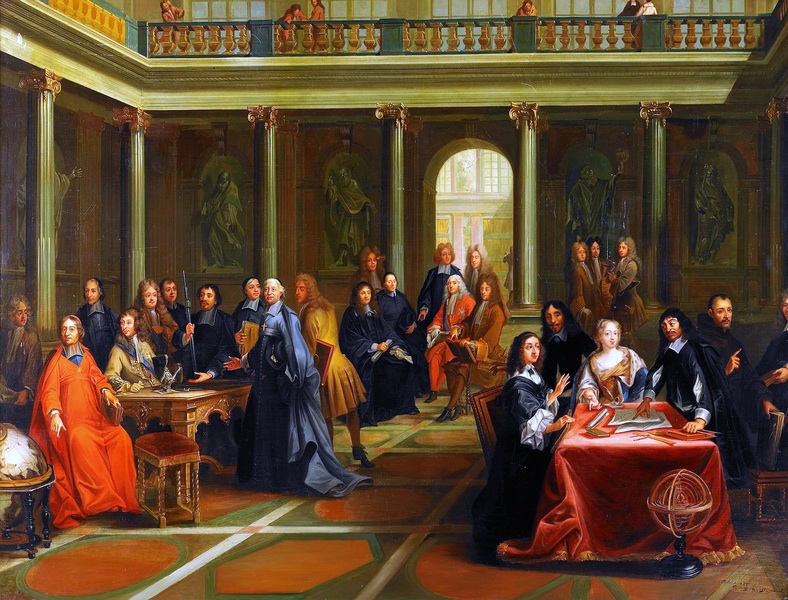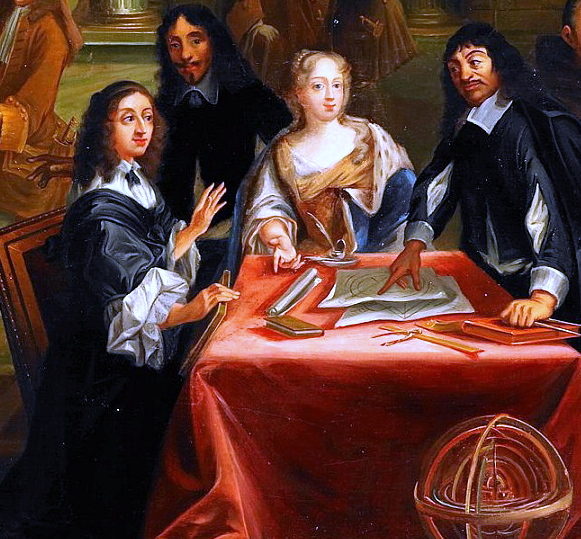|
When Queen Christina of Sweden visited Rome in 1655 Pope Alexander VII had the inside of the gate redesigned by Bernini in her honor. The pope’s coat of arms (6 stones and a star) was placed above the entrance with a sign bidding welcome to the Queen: “Felici Faustoque Ingressui”.  Dispute of Queen Cristina Vasa and René Descartes - Nils Forsberg (1842-1934) after Pierre-Louis Dumesnil the Younger (1698-1781)  Built between 1578 and 1580 by the Bolognese Ottaviano Matte, architect of the Apostolic Palace, the Tower of the Winds is one of the most famous buildings of the Vatican and set up an astronomical observatory originally used in studies for the reform of the calendar promoted by Pope Gregory XIII. Circignani Decorations of the Meridian Hall , 1580-1582 Meridian Hall The Meridian Hall was originally built as an open gallery for astronomical observations. In 1627, the initiative of Urban VIII, the arches of the loggia and frescoed with grotesques were closed by Simone Lagi and other painters. Alexander VII made it the first residence of Queen Christina of Sweden, after his conversion to Catholicism. The room takes its name from the sundial set in the marble floor, built along all'anemoscopio fixed on time, by Ignazio Danti, cosmographer member of the Papal States and the Commission for the reform of the calendar in 1580. The frescoes on the west wall (St. Paul's Shipwreck in Malta) and south (the calming of the storm and Gerasenes The possessed) are the work of Nicholas Circignani, known as Pomarancio, author of the fresco intermediate (The Angel marks the forehead of the elect); the paintings of the vault, with the Allegories of the Seasons, hand in hand you must Matteino of Siena or the same Pomarancio. In 1891 the Tower of the Winds became the seat of the Vatican Observatory, founded by Pope Leo XIII in that year. SALA DELLA MERIDIANA La Sala della Meridiana originariamente fu costruita come un loggiato aperto destinato alle osservazioni astronomiche. Nel 1627, per iniziativa di Urbano VIII, le arcate della loggia furono chiuse e affrescate a grottesche da Simone Lagi e altri pittori. Alessandro VII ne fece la prima residenza della regina Cristina di Svezia, subito dopo la sua conversione al Cattolicesimo. La Sala prende il nome dalla meridiana in marmo incastonata nel pavimento, realizzata, assieme all’anemoscopio fissato sulla volta, da Ignazio Danti, cosmografo pontificio e membro della Commissione per la riforma del calendario, nel 1580. Gli affreschi della parete ovest (Naufragio di S. Paolo a Malta) e sud (La tempesta sedata e L’indemoniato geraseno) sono opera di Nicolò Circignani, detto il Pomarancio, autore anche dell’affresco intermedio (L’Angelo che segna la fronte degli eletti); le pitture della volta, con le Allegorie delle Stagioni, si devono invece alla mano di Matteino da Siena o dello stesso Pomarancio. Nel 1891 la Torre dei Venti divenne la sede della Specola Vaticana, fondata proprio in quell’anno da Leone XIII. Title LA TORRE DEI VENTI IN VATICANO Authors F. MANCINELLI, J. CASANOVAS Publisher Citta'del Vaticano : Libreria Editrice Vaticana, 1980 Length 49 pages La Torre dei venti in Vaticano / Mancinelli, Fabrizio (ISBN 8820900211) Il Bernini : la sua vita, la sua opera, il suo tempo Author: Stanislao Fraschetti; Adolfo Venturi Publisher: Milano : U. Hoepli, 1900. The Vatican Observatory, in view of its historical roots, can be considered one of the oldest astronomical observatories in Europe still in operation. Its origin can be traced to the fact the second half of the sixteenth century when Pope Gregory XIII (1575-1585) invited astronomers and mathematicians of the Collegio Romano in preparing the reform of the calendar then promulgated in 1582. The old chronicles tell that Gregory XIII in 1576, the Vatican, in the way of the Foundation, he built his architect Matte 73 meters high tower, which still exists today and is known under the name "Tower of the Winds" (see Mancinelli and Casanovas, 1980). The most important thing in this room, under the aspect of astronomy, is the famous meridian line built by Father Ignazio Danti (1537-1586). In the south wall is a hole (which the artist made to coincide with the mouth of a genius who blows), through which a sunbeam is to hit the floor. This is traversed, from north to south by a long strip of marble that extends to the disk in the center. On this strip is drawn the line of the meridian, while the signs of the zodiac are engraved exactly the point where, when the sun enters the constellation on the solar ray passing through the hole beats at noon. In one of these points are the same thing equinoctial signs of early spring and autumn. On this meridian Gregory XIII in person will be able to see the absolute necessity of reform of the calendar already being implemented. However, it was only towards the end of the eighteenth century that the "Tower of the Winds" were installed the first astronomical instruments. But opposed to this project Calandrelli Joseph (1749-1827) astronomer priest, teacher of mathematics at the Collegio Romano after the suppression of the Jesuits: he believed that the Observatory, designed to teach astronomy at the same time in the Roman College, came to found in the Vatican too far from the city center. http://www.disf.org/Voci/173.asp |